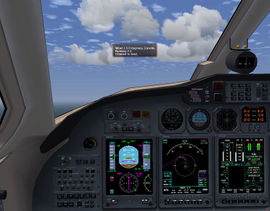Spoken ATC
 | |
| Started in | 07/2017 |
|---|---|
| Description | Spoken ATC |
| Maintainer(s) | Rodolfo |
| Contributor(s) | Rodolfo (rleibner on the forum) |
| Status | Under active development as of 07/2017 |
The Spoken ATC addon allows the pilot to listen to the directives of the Air Traffic Controller.
The addon is not intended to compete with FGComm, Festival or other similar features. On the contrary, it is meant to substitute them when these are not available (for example due to constrained hardware resources, no Internet connection, etc.)[1]
Preface
Typically, you should tune the ATC-station frequency and make a request by pressing < key. You may hear something like:
- "Charlie X-ray Bravo Echo X-ray , this is Montevideo Carrasco International tower. QNH 1024 or 30 point 24 inches. Join left pattern Runway 1 9 and report."
So, you enter in the base leg and press < again:
- "Charlie X-ray Bravo Echo X-ray , Wind 1 5 0 degrees, 3 knots. Runway 1 9 cleared to land."
After landing and while you are braking, you press < once more:
- "Charlie X-ray Bravo Echo X-ray , Exit Runway at first taxiway and contact Ground 121 point 82."
That is only an example of standard VFR Phraseology that you can expect from Spoken ATC.
How to install
| Note This is the latest version, v.2.2.4 (Apr 26, 2019) |
Download this addon from SourceForge. Read the directions as a reference.
Start your FGFS session including --addon=<your local path>/SpokenATC in the command line or in the settings tab of the launcher.
How to use it
Launch FlighGear (or re-start it) and tune Comm1 to an available ATC frequency (you can find them at Menu/Location/Airfield information), and press the < key to transmit your request.
You will hear the ATC's answer according the standard VFR phraseology, depending on your current position, weather and previous messages:
- If you are on ground:
- The code interprets it's a taxi request (if you are far from the runway or you've just landed),
- or a take-off request (if you are on the correct Runway or at his holding point).
- If you are flying:
- The code interprets it's an approach request (if you tunned an APP station),
- or a landing request (if you tunned a TWR station),
- or a departure request (if you tunned a DEP station. and you are climbing after a take-off).
Note that only TWR stations can deliver landing or take-off clearances, and only GND or TWR stations can deliver taxiing ones.
Where there is not a specific GND or APP-DEP freq., TOWER can take their tasks.
If they do exist, TWR will redirect to the specific frequency.
Only at initial contact, the ATC message includes his station name & type, and the current QNH.
APP stations will give a vector to the runway threshold in use (if you are far from there) or order to contact TWR (if you are inside the CTR).
TWR stations will give instructions to join pattern or make direct final (depending on your position).
Comming soon
Next version (under development now) includes 2 new features:
- User can toggle anytime between Comm1 and Comm2 by pressing Alt<
- Can request for a vector to the closest airport by pressing CtrlAlt<
In addition to that, now you will hear the pilot's voice requesting ATC instructions and their acknowledges.
You can taste (& test) those facilities by replacing the files in your <SpokenATC> folder with the ones included here: next (beta) version.
Tips
Heavy airplanes
To request a ILS runway, contact Tower using Ctrl<.
A realistic behavior
To achieve realistic behavior, follow a logical sequence of communications, viz.:
- Contact GND (or TWR) prior to taxiing.
- Contact TWR prior to take-off or land.
- Contact DEP (if available) after take-off to leave the CTR.
- Contact APP (if available) prior to enter the CTR.
- etc, etc.
On screen voice
If the writen messages bother you, when binding (see above) you can call the function as
<script> <![CDATA[ spoken_atc.speak(n); ]]> </script>
with n seconds you want, even 0 meaning no messages at all.
Phraseology customization
You can customize the phraseology by editing the phraseology.xml file.
There you can find groups of tags like:
. . . .
<foo type="string">Hello world. </foo>
<foo type="string">It is a good </foo>
<foo type="string">day </foo>
<foo type="string">to fly. </foo>
. . . .
which will be read as a single sentence ("Hello world. It is a good day to fly. ").
Literals
Those in the example above are literal sentences that you can change by the strings you want.
Note
|
Substitutions
Strings starting by % will call some property value.
In the example above replace day by % /sim/startup/time-offset-type.
Now the sentence will be read as "Hello world. It is a good morning to fly. " or "Hello world. It is a good evening to fly. " depending on the time.
Note
|
Concatenation
Strings starting by ~ will append the sentence with another one.
Try this:
. . . .
<short type="string">% /satc/callsign-fmt</short>
<short type="string">, </short>
<foo type="string">Have a nice fly, </foo>
<foo type="string">~short</foo>
. . . .
when calling foo you should hear "Have a nice fly, <your-callsign> , "
Word Replacement
If you find that the word Wind is not pronounced clearly, you can change it by Winnded or similar to increase its intelligibility.
Better? Fine, but what about the message on the screen?
Include a tag with the pattern <replace type="string">'''old''':'''new'''</replace>:
. . . .
<replace type="string">Winnded:Wind</replace>
. . . .
Besides that, you can call the spoken_atc.say() function at runtime to check your customization.
spoken_atc.say() function
You can ... [TODO]
And remember this is VFR: heed the instructions of the ATC but keep your eyes wide open !
References
| References |
Related content
Wiki articles
- ATC phraseology
- Howto:Implementing a simple GCA system - Ground Controlled Approaches
- Spoken GCA